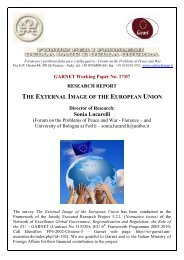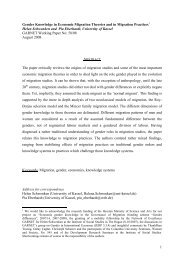GARNET Working Paper No. 13/07
GARNET Working Paper No. 13/07
GARNET Working Paper No. 13/07
You also want an ePaper? Increase the reach of your titles
YUMPU automatically turns print PDFs into web optimized ePapers that Google loves.
Shaw, 2003, Farrell, Hettne and Langenhove, 2005), the emergence of regional zones of<br />
peace (Kacowicz, 1995; 1997; 1998), the regional diffusion of insecurity and conflict<br />
(Wallensteen and Sollenberg, 1998; Rubin, 2002), to the growing capacity of regional<br />
organizations in dispute settlement and peace enforcement (Diehl and Lepgold, 2003; Pugh<br />
and Singh, 2003; Graham and Felício, 2006), triggered the interest over the regional level of<br />
analysis in peace and security.<br />
The article is divided in three parts. Firstly, the overall objective is identified and the<br />
literature is schematically reviewed. Secondly, it explores the link between peace and<br />
security to unveil both their conceptual dependency and their comprehensiveness. The aim is<br />
to expound the nature of both concepts in order to facilitate our understanding of how they<br />
connect to the regional dimension. Finally, equipped with those assumptions, the article<br />
describes systematically the different ways in which peace and security cluster regionally.<br />
RESEARCH GOAL<br />
The aim of this article is to problematize and comprehend how peace and security cluster at<br />
the regional level. In conceptual and practical terms security is associated to the management<br />
of threats (Baldwin, 1997), whereas peace should be conceptualized as a state attained by the<br />
successful transformation of structural 5 and direct violence (Galtung, 1969). One of the<br />
intriguing aspects about these concepts is that they are relational i.e. the attainment of peace<br />
and security presupposes the existence of the ‘other’, the agent(s) with whom an inimical or<br />
amicable relationship is established. This triggers the question over the spatial extension of<br />
these peace and security relationships.<br />
Despite the increasingly globalized world, peace and security relations between different<br />
agents are necessarily bound by a physical link. Even if it is technically possible for a<br />
security and peace relationship to be established between two states located in opposite ends<br />
of the globe or, conversely, other relationships are micro-localized and involve only smalldefinite<br />
objectives that are aimed at the creation of linkages between social actors, whereas regionalization pertains to the<br />
process through which those linkages are created. Regionalization is, in most cases, directly associated to regionalism, i.e. it<br />
is caused by a deliberate intention of specific actors to pursue integration and cooperation at regional level. However,<br />
regionalization may also come about spontaneously and unintentionally with no ideology or formal intentional process<br />
behind it (see Söderbaum, 2002:5).<br />
5 According to Galtung, structural violence occurs whenever people are disadvantaged by political, legal, economic or<br />
cultural traditions or, as he puts it, it refers to any constraint on human potential due to economic and political structures<br />
(1969:183)<br />
3





